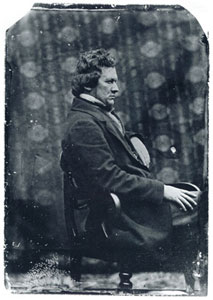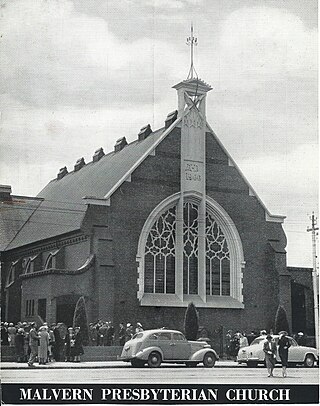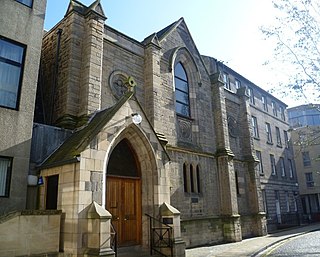
Perth is a city in central Scotland, on the banks of the River Tay. It is the administrative centre of Perth and Kinross council area and is the historic county town of Perthshire. It had a population of about 47,430 in 2018.
The United Presbyterian Church (1847–1900) was a Scottish Presbyterian denomination. It was formed in 1847 by the union of the United Secession Church and the Relief Church, and in 1900 merged with the Free Church of Scotland to form the United Free Church of Scotland, which in turn united with the Church of Scotland in 1929. For most of its existence the United Presbyterian Church was the third largest Presbyterian Church in Scotland, and stood on the liberal wing of Scots Presbyterianism. The Church's name was often abbreviated to the initials U.P.

Adam Gib was a Scottish religious leader, head of the Antiburgher section of the Scottish Secession Church. He reportedly wrote his first covenant with God in the blood of his own veins. Gib was born in the parish of Muckhart, in southern Perthshire on 15 April 1714.

Ebenezer Erskine was a Scottish minister whose actions led to the establishment of the Secession Church.

Ralph Erskine was a Scottish churchman.

Alexander "Greek" Thomson was an eminent Scottish architect and architectural theorist who was a pioneer in sustainable building. Although his work was published in the architectural press of his day, it was little appreciated outside Glasgow during his lifetime. It has only been since the 1950s and 1960s that his critical reputation has revived—not least of all in connection with his probable influence on Frank Lloyd Wright.

St Andrew's and St George's West Church serves Edinburgh's New Town, in Scotland. It is a congregation of the Church of Scotland. The parish today constitutes the whole of the First New Town of Edinburgh and a small part of the early-19th-century Second New Town of Edinburgh. The church building was completed in 1784, and is now protected as a category A listed building.

St Ninian's Cathedral in Perth is a cathedral of the Scottish Episcopal Church in the Diocese of St Andrews, Dunkeld and Dunblane.
Frederick Thomas Pilkington (1832-1898), pupil of his father, was a "Rogue" British architect, practising in the Victorian High Gothic revival style. He designed mostly churches and institutional buildings in Scotland. Typical of his work is the Barclay Church in Edinburgh, a polychrome stone structure with early French Gothic details.

St. Vincent Street Church is a Presbyterian church on St. Vincent Street in Glasgow, Scotland. It was designed by Alexander Thomson and built from 1857 to 1859 for the former United Presbyterian Church of Scotland. Elements are by Thomson's young assistant, the church architect Robert Gordon Wilson, who was a member of the UP church.

James Fisher (1697–1775) was one of the founders of the Scottish Secession church. He was born at Barr, on 23 January 1697, the second son of Thomas Fisher, minister of Rhynd. He was educated at University of Glasgow. He was licensed by the Presbytery of Perth on 31 October 1722 and subsequently called and ordained on 23 December 1725. He dissented and joined with his father-in-law Ebenezer Erskine in his appeal and complaint to the Assembly of 1733. He was one of the four original members of the Associate Presbytery founded at Gairney Bridge on 6 December 1733. He was deposed by the General Assembly on 15 May 1740, but continued to preach in the parish church till 13 August 1741, when he was forcibly ejected on a sheriff's warrant. He then preached in a tent on Kinclaven brae during the time he remained in the district. On 8 October 1741 he became minister of Shuttle Street Associate Congregation, Glasgow. He was deposed by the Associate (Antiburgher) Synod on 4 August 1748 over the question of the Burgess Oath. He was appointed Professor of Divinity by the Associate (Burgher) Synod in 1749. He died on 28 September 1775.

Malvern Presbyterian Church is located in Victoria, Australia. Opened in 1886, it was the first Presbyterian Church to be founded in the City of Malvern and is now within Stonnington, a metropolitan area of Melbourne.

The King Khalid Building is an event space in the Southside, Edinburgh, Scotland, owned and operated by the Royal College of Surgeons of Edinburgh. The building was constructed Roxburgh Free Church in 1847 and converted to its current use in 1982.
Charles Ower (1813–1876) and son (1849–1921) were father and son architects, operating in eastern Scotland.

Robert Gordon Wilson (1844–1931) was a 19th/20th century Scottish architect based in Aberdeen. He was from a strong United Presbyterian background and specialised in churches for the United Presbyterian Church and Free Church of Scotland.
William Wilson was born in Glasgow, on 9 November 1690. He was the son of Gilbert Wilson, proprietor of a small estate near East Kilbride.. William Wilson's mother was Isabella, daughter of Ramsay of Shielhill. William was named after William of Orange and was educated at University of Glasgow, graduating with an M.A. in 1707. He was licensed by the Presbytery of Dunfermline on 23 September 1713 and called unanimously on 21 August 1716. He was ordained on 1st November 1716. He had a call to Rhynd, but was continued by the Presbytery in Perth. Associating with the supporters of the Marrow of Modern Divinity, he with three others Ebenezer Erskine, Alexander Moncrieff, and James Fisher laid the foundation of the Secession Church, for which they were suspended by the Commission of Assembly 9 August, and declared no longer ministers of the Church 12 November 1733. He was deposed by the Assembly 15 May 1740. He and his people erected a meeting-house, and the Associate Presbytery appointed him their Professor of Divinity, 5 November 1736, but he sank under his contentions and labours and died 8 October 1741. He is said to have combined "the excellencies of both Erskines, with excellencies peculiar to himself."

St John the Baptist Church is located in Perth, Perth and Kinross, Scotland. Of Scottish Episcopalian denomination, it is located on Princes Street, at its junction with Canal Street, in the southeastern corner of the city centre. It adjoins the Greyfriars Burial Ground on its western side. Completed in 1851, it is now a Category B listed building. The church's architects were John Hay, William Hardie Hay and James Murdoch Hay, three brothers from Liverpool.
William Erskine Thomson was a Scottish architect prominent in the late 19th and first half of the 20th centuries. He designed several notable buildings in Scotland, mostly including churches and villas. Several of his works are now listed structures.

Pleasance Church was a Presbyterian church on the Pleasance in the Southside of Edinburgh, Scotland. Originating in the Relief Church in the 1820s, the congregation united with Charteris Memorial in 1953.














